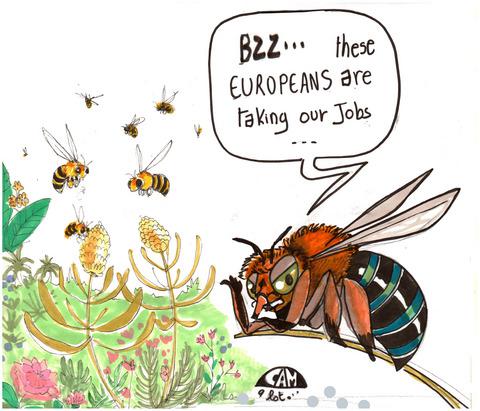当前位置:
X-MOL 学术
›
Austral Ecol.
›
论文详情
Our official English website, www.x-mol.net, welcomes your feedback! (Note: you will need to create a separate account there.)
Impacts of the introduced European honeybee on Australian bee-flower network properties in urban bushland remnants and residential gardens
Austral Ecology ( IF 1.5 ) Pub Date : 2021-05-19 , DOI: 10.1111/aec.13040 Kit S. Prendergast 1 , Jeff Ollerton 2
Austral Ecology ( IF 1.5 ) Pub Date : 2021-05-19 , DOI: 10.1111/aec.13040 Kit S. Prendergast 1 , Jeff Ollerton 2
Affiliation

|
The European honeybee Apis mellifera is a highly successful, abundant species and has been introduced into habitats across the globe. As a supergeneralist species, the European honeybee has the potential to disrupt pollination networks, especially in Australia, whose flora and fauna have co-evolved for millions of years. The role of honeybees in pollination networks in Australia has been little explored and has never been characterised in urban areas, which may favour this exotic species due to the proliferation of similarly exotic plant species which this hyper-generalist can utilise, unlike many native bee taxa. Here, we use a bipartite network approach to compare the roles, in terms of species-level properties, of honeybees with native bee taxa in bee-flower (‘pollination’) networks in an urbanised biodiversity hotspot. We also assessed whether the abundance of honeybees influences overall network structure. Pollination networks were created from surveys across seven residential gardens and seven urban native vegetation remnants conducted monthly during the spring-summer period over two years. There were consistent differences in species-level properties between bee taxa, with honeybees often differing from all other native bees. Honeybees had significant impacts on network properties, being associated with higher nestedness, extinction slopes of plants, functional complementarity and niche overlap (year two), as well as lower weighted connectance and generalisation. These associations all are indicative that competition is occurring between the introduced honeybee and the native bee taxa in bee-flower networks. In conclusion, the introduced honeybee occupies a dominant, distinct position in bee-flower networks in urban habitats in the southwest Western Australian biodiversity hotspot and has a major, potentially disruptive, influence on plant-pollinator network properties in these areas.
中文翻译:

引进的欧洲蜜蜂对城市丛林遗迹和住宅花园中澳大利亚蜂花网络特性的影响
欧洲蜜蜂Apis mellifera是一种非常成功、丰富的物种,并已被引入全球各地的栖息地。作为一个超通用的物种,欧洲蜜蜂有可能破坏授粉网络,尤其是在澳大利亚,其动植物已经共同进化了数百万年。蜜蜂在澳大利亚授粉网络中的作用很少被探索,也从未在城市地区得到表征,这可能有利于这种外来物种,因为与许多本地蜜蜂类群不同,这种超多面手可以利用的类似外来植物物种的增殖. 在这里,我们使用二分网络方法来比较城市化生物多样性热点中蜜蜂花(“授粉”)网络中蜜蜂与本地蜜蜂类群在物种水平特性方面的作用。我们还评估了蜜蜂的数量是否会影响整体网络结构。授粉网络是通过在两年的春夏期间每月对七个住宅花园和七个城市原生植被残留物进行的调查而创建的。蜜蜂分类群之间的物种水平特性存在一致的差异,蜜蜂通常与所有其他本地蜜蜂不同。蜜蜂对网络特性有显着影响,与更高的嵌套性、植物的灭绝斜率、功能互补性和生态位重叠(第二年)以及较低的加权连接和泛化有关。这些关联都表明在蜂花网络中引入的蜜蜂和本地蜜蜂类群之间正在发生竞争。综上所述,
更新日期:2021-05-19
中文翻译:

引进的欧洲蜜蜂对城市丛林遗迹和住宅花园中澳大利亚蜂花网络特性的影响
欧洲蜜蜂Apis mellifera是一种非常成功、丰富的物种,并已被引入全球各地的栖息地。作为一个超通用的物种,欧洲蜜蜂有可能破坏授粉网络,尤其是在澳大利亚,其动植物已经共同进化了数百万年。蜜蜂在澳大利亚授粉网络中的作用很少被探索,也从未在城市地区得到表征,这可能有利于这种外来物种,因为与许多本地蜜蜂类群不同,这种超多面手可以利用的类似外来植物物种的增殖. 在这里,我们使用二分网络方法来比较城市化生物多样性热点中蜜蜂花(“授粉”)网络中蜜蜂与本地蜜蜂类群在物种水平特性方面的作用。我们还评估了蜜蜂的数量是否会影响整体网络结构。授粉网络是通过在两年的春夏期间每月对七个住宅花园和七个城市原生植被残留物进行的调查而创建的。蜜蜂分类群之间的物种水平特性存在一致的差异,蜜蜂通常与所有其他本地蜜蜂不同。蜜蜂对网络特性有显着影响,与更高的嵌套性、植物的灭绝斜率、功能互补性和生态位重叠(第二年)以及较低的加权连接和泛化有关。这些关联都表明在蜂花网络中引入的蜜蜂和本地蜜蜂类群之间正在发生竞争。综上所述,

























 京公网安备 11010802027423号
京公网安备 11010802027423号